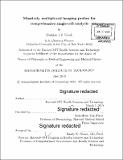| dc.contributor.advisor | Seok-Hyun Yun. | en_US |
| dc.contributor.author | Kwok, Sheldon J. J. | en_US |
| dc.contributor.other | Harvard--MIT Program in Health Sciences and Technology. | en_US |
| dc.date.accessioned | 2019-09-16T20:59:48Z | |
| dc.date.available | 2019-09-16T20:59:48Z | |
| dc.date.copyright | 2019 | en_US |
| dc.date.issued | 2019 | en_US |
| dc.identifier.uri | https://hdl.handle.net/1721.1/122129 | |
| dc.description | Thesis: Ph. D. in Medical Engineering and Medical Physics, Harvard-MIT Program in Health Sciences and Technology, 2019 | en_US |
| dc.description | Cataloged from PDF version of thesis. | en_US |
| dc.description | Includes bibliographical references (pages [165]-191). | en_US |
| dc.description.abstract | Optical microscopy techniques are widely used to study cellular physiology in their native tissue environments. In particular, the use of fluorescent probes to tag different cell populations, subcellular compartments, specific proteins and nucleotide sequences has enabled examination of cellular phenotypes with increasingly sophisticated detail. Recent efforts to combine physiological imaging and single-cell molecular analysis seek complete understanding of cellular identity and function within complex tissues. Specific cells of interest can be selected and isolated from tissues for downstream molecular analyses using techniques such as laser capture micro-dissection, or cell tagging with photo-conversion. However, high-throughput, unbiased molecular profiling of every cell imaged within a tissue remains an elusive challenge. A fundamental obstacle in previous approaches is spectral overlap due to the relatively broad emission of typical fluorescent probes, which limits their capabilities for multiplexed tagging. The first part of this thesis describes methods for studying cellular physiology in mice at single-cell resolution using two-photon fluorescence microscopy. The second part of this thesis describes the development of a novel class of imaging probes, called laser particles, which rely on narrowband laser emission for massively multiplexed cell tagging. This work establishes laser particles as promising tools for comprehensive single-cell analyses. | en_US |
| dc.description.statementofresponsibility | by Sheldon J.J. Kwok. | en_US |
| dc.format.extent | 191 pages | en_US |
| dc.language.iso | eng | en_US |
| dc.publisher | Massachusetts Institute of Technology | en_US |
| dc.rights | MIT theses are protected by copyright. They may be viewed, downloaded, or printed from this source but further reproduction or distribution in any format is prohibited without written permission. | en_US |
| dc.rights.uri | http://dspace.mit.edu/handle/1721.1/7582 | en_US |
| dc.subject | Harvard--MIT Program in Health Sciences and Technology. | en_US |
| dc.title | Massively multiplexed imaging probes for comprehensive single-cell analysis | en_US |
| dc.type | Thesis | en_US |
| dc.description.degree | Ph. D. in Medical Engineering and Medical Physics | en_US |
| dc.contributor.department | Harvard--MIT Program in Health Sciences and Technology | en_US |
| dc.contributor.department | Harvard University--MIT Division of Health Sciences and Technology | |
| dc.identifier.oclc | 1119539098 | en_US |
| dc.description.collection | Ph.D.inMedicalEngineeringandMedicalPhysics Harvard-MIT Program in Health Sciences and Technology | en_US |
| dspace.imported | 2019-09-16T20:59:46Z | en_US |
| mit.thesis.degree | Doctoral | en_US |
| mit.thesis.department | HST | en_US |

